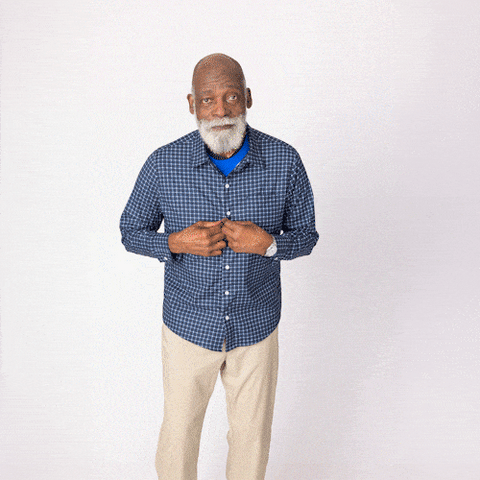Magnetic Adaptive Clothing Vs Velcro Clothing
Understanding Magnetic Adaptive Clothing

Magnetic adaptive clothing is designed with convenience and ease of use in mind. These garments feature hidden magnets strategically placed within the fabric, offering a unique way to fasten and unfasten clothing. The magnetic closures eliminate the need for buttons or zippers, making dressing a breeze, even with just one hand and for those with limited dexterity. This type of closure is particularly helpful for people who live with conditions like tremors, arthritis, poor vision, or limited mobility due to a Stroke.
Key Features:
- Magnetic Fastenings: Magnets, concealed beneath the fabric, create a secure closure that’s easy to manipulate. For example, imagine a magnetic shirt where you can effortlessly close the front with just a gentle touch, which makes it ideal for those with arthritis or weakened hand strength.
- Independence: Magnetic clothing empowers seniors to dress independently, promoting self-reliance. An older individual can regain a sense of control over their daily routines and maintain their dignity when they can easily don magnetic attire. This one adaptive product could be the key for some to be able to dress independently without caregiver assistance.
- Sleek Design: Magnetic closures are discreet, maintaining a stylish and traditional appearance in clothing. From the outside, magnetic clothing looks no different from regular garments, preserving one’s sense of style and fashion.
Exploring Velcro Adaptive Clothing

Velcro adaptive clothing, on the other hand, relies on hook-and-loop fasteners. These fasteners provide a secure closure that’s easy to manage, making them an excellent choice for seniors who prefer a familiar and straightforward solution.
Key Features:

- Ease of Use: Velcro closures are simple to open and close, ideal for individuals with arthritis or limited hand dexterity. For example, Velcro pants can be effortlessly adjusted for a comfortable fit, ensuring no fuss or struggle during the dressing process. Velcro provides a large target, allowing the wearer some wiggle room, so they don’t need to perfectly align each piece of Velcro for it to remain secure.
- Customizable Fit: Velcro allows for adjustments, ensuring a comfortable and snug fit. A Velcro shirt with adjustable closures enables the wearer to tailor the fit to their liking, accommodating changes in body shape or swelling.
- Wide Variety: Velcro adaptive clothing comes in various styles, including Velcro button-down shirts, pants, and more. You can choose from a diverse range of clothing items that suit your preferences and Lifestyle.
Pros and Cons: Magnetic Clothing Vs Velcro Clothing
Let’s compare magnetic clothing and Velcro clothing to help you decide which better suits your needs best.
Magnetic Clothing Pros:

- Independence: Magnetic closures enable seniors to dress themselves, fostering a sense of self-reliance. Without having to fuss around with buttons that require fine motor skills, older adults living with a range of physical and cognitive conditions are able to dress themselves when using magnetic adaptive clothing.
- Sleek Design: Magnetic closures are hidden, maintaining a traditional appearance. Imagine a magnetic button-down shirt that looks no different from a traditional (non-adaptive) shirt. It allows seniors to continue wearing styles they love without drawing attention to their adaptive clothing.
- Ease of Use: Fastening and unfastening magnetic closures is effortless, even for those with limited dexterity. Seniors can manage magnetic clothing without struggling with buttons or zippers, enhancing their overall dressing experience.
Magnetic Clothing Cons:
- Limited Fasteners: Some magnetic clothing may have fewer fasteners than traditional clothing, potentially affecting the overall fit. For example, a magnetic shirt may have fewer buttons than its non-adaptive counterpart, which could impact the fit for some wearers.
- Careful Handling: Magnets require careful handling to prevent damage or misalignment. While magnetic closures are durable, they need to be handled gently to ensure they maintain their effectiveness over time.
- Not Safe for Everyone: Magnets can impact the functioning of pacemakers and some other medical devices, preventing some individuals from using them.
- Limited Location: Certain locations on clothing are not ideal for magnets. For example, magnetic sleeve cuffs or a magnetic top button on a shirt could stick to jewelry or metal furniture.
Velcro Clothing Pros:

- Adaptability: Velcro closures can be easily adjusted for a secure and comfortable fit. Think of Velcro shoes that can accommodate changes in foot size or swelling, providing a customizable solution for individuals with varying needs.
- Wide Variety: Velcro adaptive clothing is available in various styles and options, catering to individual preferences. From Velcro pants to Velcro button-down shirts, there’s a broad selection to choose from, ensuring you can find clothing that aligns with your style.
- Ease of Use: Velcro closures are straightforward to manage, making them ideal for seniors with hand mobility issues. For instance, Velcro pants are designed with simplicity in mind, allowing wearers who don’t have full dexterity to easily open and close them or the need to perfectly align both pieces of Velcro.
Velcro Clothing Cons:

- Visibility: Velcro closures are often more visible than magnetic closures, affecting the overall aesthetics. While Velcro is functional, some individuals may prefer a more discreet closure option.
- Noise: Velcro can produce a distinct sound when opened, which may not be ideal in quiet environments. For instance, if you’re in a library or a meeting, the noise of opening a Velcro fastener could be disruptive.
- Durability: Repeated washing and usage of Velcro can wear down their effectiveness. Additionally, when washed with other clothing, lint, and other substances nearby will end up sticking to the Velcro.
How To Choose the Right Option?

Selecting between magnetic and Velcro clothing comes down to personal preferences and individual needs. Here are some factors to consider when making your decision:
- Individual Needs: Assess your specific requirements, such as the level of assistance needed and any dexterity limitations. For example, if you have severe arthritis, you might lean towards magnetic clothing for its effortless closure system.
- Comfort: Consider which closure type aligns with your comfort level and ease of use. Think about how each option feels when you put on and take off the clothing. Is one more comfortable for you than the other?
- Durability: Evaluate the durability of the closures, ensuring they withstand regular wear and washing. You want clothing that maintains its functionality and appearance over time.
- Style Preferences: Think about your style preferences and how each type of closure may impact the overall look of your clothing. Consider the types of clothing you enjoy wearing and how adaptive closures fit into your wardrobe.
- Trial and Error: Don’t hesitate to try both magnetic and Velcro clothing to determine which one suits you best. Sometimes, personal experience is the most effective way to make a decision.
In the world of adaptive clothing, both magnetic and Velcro options provide valuable solutions for seniors and individuals with specific needs. Your choice should align with your unique requirements, comfort, and style preferences. By weighing the pros and cons of magnetic and Velcro clothing, you can make an informed decision that enhances your dressing experience and overall well-being.
























